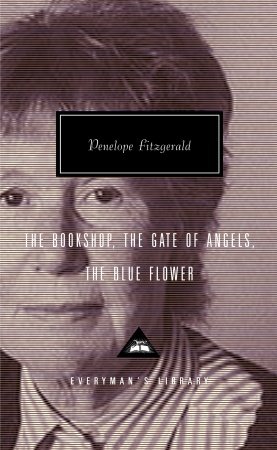It’s okay if you haven’t heard of Penelope Fitzgerald. I hadn’t either. I’m an English major who loves British literature and I didn’t even recognize the name, let alone seen any of her stuff. I am not a “cut-and-paster” but I think she needs a little introduction. This is from the book’s author bio.
Penelope Fitzgerald, who died in 2000, emerged late in life as one of the most remarkable English writers of the last century. She began her writing career in 1975 at the age of fifty-nine, and over the next two decades she published three biographies, nine novels, and a collection of short stories. Now three of her acclaimed novels are gathered here in one volume.
The Bookshop is a postwar tragicomedy of manners, set in an isolated seaside town where an enterprising woman opens a bookstore only to find it beset by poltergeists, weather, and hostile townsfolk. The Gate of Angels is an Edwardian romance within a novel of ideas: a young doctor devoted to science and to his all-male Cambridge college finds his life and views disrupted by a nurse named Daisy. The Blue Flower, which won the National Book Critics Circle Award, revitalizes historical drama through the story of Novalis, an eighteenth-century German romantic poet and visionary genius, and his unlikely love affair with a simple child-woman.
These three novels all display Fitzgerald’s characteristic wit, intellectual breadth, and narrative brilliance, applied to an array of traditional forms into which she breathed new life.
My second confession is that I have only read the first of these novels, The Bookshop, so far (the book is several hundred pages long). I intend to read the others and the galley of the biography about her as soon as I can. My review, therefore, will focus on this first novel.
I suppose I could say I started with this one because it appears first, which wouldn’t altogether be a lie. But it’s also because the story idea appealed to me so much. It is a strange dream of mine to move to England and open a bookstore in a small town.What literary person wouldn’t.
In this case, Florence is recently widowed. She lives alone, and simply, in a seaside town called Hardsborough. It’s 1959 but England is still weary from the war. The home front survivors are terrified of change that might upset the balance that has so carefully been met. Bored and determined, she decides to get a small business loan and open a bookshop in town. She purchases an unused property, often said to be haunted, and turns it into her business.
Those who had lived in Hardsborough for some time also knew that her freehold was haunted. The subject was not avoided, it was a familiar one. The figure of a woman, for example, could sometimes be seen down at the landing-stage of the ferry, about twilight, waiting for her son to come back, although he had been drowned over a hundred years ago. But the Old House was not haunted in a touching manner. It was infested by a poltergeist which, together with the damp and the unsolved question about the drains, partly accounted for the difficulty in selling the property. The house agent was in no way legally bound to mention the poltergeist, though he perhaps alluded to it in the phrase unusual period atmosphere. ~ Pgs. 13-14
It’s this wittiness that moves the story along. The plot itself unfolds rather simply, with the main crux of the novel being, will the story succeed and Florence be accepted? And what will the ghost have to say about it?
It is also delicious British. Not only is the setting like a Cornish town in Daphne du Maurier, but Penelope’s clipped and underhanded way of speaking is so properly British. She comports herself with perfect decorum while slicing away at someone with her tongue. Sharp insults are masked within polite conversation and letters.
There are overarching themes — perseverance in the face of futility, life is unpredictable, allowing yourself to go where the wind takes you — which weave in and out. Mostly, it is a short glimpse into a postwar woman’s psyche and, much like the town itself, how she struggles to find a place in the new society that has been left behind.
Many thanks to Katie at Knopf/Everyman for the review copy.
Hardcover: 512 pages
Publisher: Everyman’s Library (September 23, 2003)
Language: English
ISBN-10: 1400041260
ISBN-13: 978-1400041268
Product Dimensions: 5.3 x 1.1 x 8.3 inches

